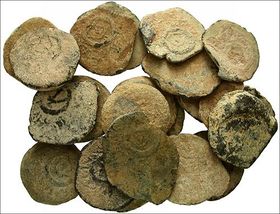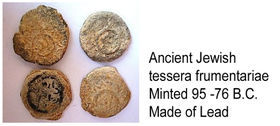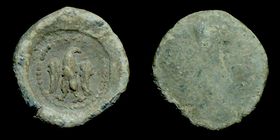Tesserae: Difference between revisions
No edit summary |
No edit summary |
||
| Line 1: | Line 1: | ||
[[Image:tesserae-lead-Alexander-Jannaeus.jpg|link=Tesserae|280px|right|thumb|]] | [[Image:tesserae-lead-Alexander-Jannaeus.jpg|link=Tesserae|280px|right|thumb|]] | ||
These tokens known as ''tesserae'', meaning "tile". They were evidence of your entitlements but also of your entanglements under Roman authority of the Roman [[world]]. | These tokens known as ''tesserae'', meaning "tile". They were evidence of your entitlements but also of your entanglements under Roman authority of the Roman [[world]]. | ||
[[Image:tesserae-hopitales.jpg|link=Tesserae|280px|right|thumb|]] | |||
As a means of identification the original parties exchanged or displayed these tokens or tesserae hospitālēs. | As a means of identification the original parties exchanged or displayed these tokens or tesserae hospitālēs. | ||
| Line 17: | Line 14: | ||
When a stranger claimed ''hospitium'' his ''tessera'' had to be produced and submitted for examination. If it was found to be genuine, he was entitled to all the privileges that the best-known guest-friend could expect. | When a stranger claimed ''hospitium'' his ''tessera'' had to be produced and submitted for examination. If it was found to be genuine, he was entitled to all the privileges that the best-known guest-friend could expect. | ||
"This same systems was use to provide government welfare. It is clear that these are almost precisely the duties an practices devolving upon members of our own great benevolent societies at the present time when appealed to by a citizen in distress."<Ref>THE PRIVATE LIFE OF THE ROMANS BY HAROLD WHETSTONE JOHNSTON PROFESSOR OF LATIN IN THE INDIANA UNIVERSITY CHICAGO SCOTT, FORESMAN AND COMPANY 1909</Ref> | "This same systems was use to provide government [[Welfare|welfare]]. It is clear that these are almost precisely the duties an practices devolving upon members of our own great benevolent societies at the present time when appealed to by a citizen in distress."<Ref>THE PRIVATE LIFE OF THE ROMANS BY HAROLD WHETSTONE JOHNSTON PROFESSOR OF LATIN IN THE INDIANA UNIVERSITY CHICAGO SCOTT, FORESMAN AND COMPANY 1909</Ref> | ||
There has always been two basic [[Welfare types]] in societies throughout history. They often are a key to sealing the fate of society an nations. | |||
These clay tiles that became a ''titulus'' in a welfare state were not a new thing to Romans. | |||
A ''tessera'' was the ancient Roman equivalent of a theater ticket. Stamped into a clay shard was an entrance aisle and row number for spectators attending an event at an amphitheater or arena. Above the doors of the Colosseum in Rome are numbers corresponding to those stamped into a spectator's tessera. | A ''tessera'' was the ancient Roman equivalent of a theater ticket. Stamped into a clay shard was an entrance aisle and row number for spectators attending an event at an amphitheater or arena. Above the doors of the Colosseum in Rome are numbers corresponding to those stamped into a spectator's tessera. | ||
[[Image:tessera-frumentariae.jpg|link=Tesserae|280px|right|thumb|]] | |||
''Tesserae frumentariae'' and ''nummariae'' were tokens given at certain times by the Roman magistrates to citizens, in exchange for which they received a fixed amount of wheat or money.<Ref>Smith, Sir William (1859), A dictionary of Greek and Roman antiquities (2 ed.), Little, Brown, and Co., p. 550 [http://en.wikipedia.org/wiki/Tessera_%28commerce%29] </Ref> | ''Tesserae frumentariae'' and ''nummariae'' were tokens given at certain times by the Roman magistrates to citizens, in exchange for which they received a fixed amount of wheat or money.<Ref>Smith, Sir William (1859), A dictionary of Greek and Roman antiquities (2 ed.), Little, Brown, and Co., p. 550 [http://en.wikipedia.org/wiki/Tessera_%28commerce%29] </Ref> | ||
TES′SERA, dim. TESSE′RULA and TESSEL′LA (κύβος), a square or cube; a die; a token. "a small tablet (as of wood, bone, or ivory) used by the ancient Romans as a ticket, tally, voucher, or means of identification[http://www.merriam-webster.com/dictionary/tessera] " | TES′SERA, dim. TESSE′RULA and TESSEL′LA (κύβος), a square or cube; a die; a token. "a small tablet (as of wood, bone, or ivory) used by the ancient Romans as a ticket, tally, voucher, or means of identification[http://www.merriam-webster.com/dictionary/tessera] " | ||
"The Roman Empire used tiles called ''tesserae'' to identify slaves, soldiers, and citizens over 2,000 years ago."[http://www.lawandliberty.org/ID_tech.htm] | [[Image:tesserae-TessEagle.jpg|link=Tesserae|280px|right|thumb|]] | ||
The Roman symbol was the eagle and they used these tiles for centuries for many purposes. But as the citizens became more and more dependent and enfranchised "The Roman Empire used tiles called ''tesserae'' to identify slaves, soldiers, and citizens over 2,000 years ago."[http://www.lawandliberty.org/ID_tech.htm] | |||
''Tessera frumentariae'' and nummariae were tokens given at certain times by the Roman magistrates to the poor, in exchange for which they received a fixed amount of cornº or money (Sueton. Aug. 40, 42, Nero, 11). | ''Tessera frumentariae'' and nummariae were tokens given at certain times by the Roman magistrates to the poor, in exchange for which they received a fixed amount of cornº or money (Sueton. Aug. 40, 42, Nero, 11). | ||
''Frumentariae Leges''. Similar tokens were used on various occasions, as they arose in the course of events. For example, when the Romans sent to give the Carthaginians their choice of peace or war, they sent two tesserae, one marked with a spear, the other with a Caduceus, requesting them to take either the one or the other (Gellius, X.27).From the application of this term to tokens of various kinds, it was transferred to the word used as a token among soldiers. This was the tessera militaris, the συνθημα of the Greeks. Before joining battle it was given out and passed through the ranks as a method by which the soldiers might be able to distinguish friends from foes. Thus at the battle of Cunaxa the word was "Zeus the Saviour and Victory," and on a subsequent engagement by the same troops "Zeus the Saviour, Heracles the Leader" (Xen. Anab. I.8 §16, VI.3 §25). | ''Frumentariae Leges''. Similar tokens were used on various occasions, as they arose in the course of events. For example, when the Romans sent to give the Carthaginians their choice of peace or war, they sent two tesserae, one marked with a spear, the other with a Caduceus, requesting them to take either the one or the other (Gellius, X.27). From the application of this term to tokens of various kinds, it was transferred to the word used as a token among soldiers. This was the tessera militaris, the συνθημα of the Greeks. Before joining battle it was given out and passed through the ranks as a method by which the soldiers might be able to distinguish friends from foes. Thus at the battle of Cunaxa the word was "Zeus the Saviour and Victory," and on a subsequent engagement by the same troops "Zeus the Saviour, Heracles the Leader" (Xen. Anab. I.8 §16, VI.3 §25). | ||
The soldiers of Xenophon used a verbal sign for the same purpose when they were encamped by night (VII.3 §34). Aeneas Tacticus (c24) gives various directions necessary to be observed respecting the word. Respecting the tessera or watchword in the Roman camp, see Castra, p251A . | The soldiers of Xenophon used a verbal sign for the same purpose when they were encamped by night (VII.3 §34). Aeneas Tacticus (c24) gives various directions necessary to be observed respecting the word. Respecting the tessera or watchword in the Roman camp, see Castra, p251A . | ||
Revision as of 14:06, 19 December 2013

These tokens known as tesserae, meaning "tile". They were evidence of your entitlements but also of your entanglements under Roman authority of the Roman world.

As a means of identification the original parties exchanged or displayed these tokens or tesserae hospitālēs.
In the Obligations of Hospitium there are obligations imposed by a covenant were of the most sacred character, and any failure to regard its provisions was considered sacrilege, bringing upon the offender, the anger of Iuppiter Hospitālis..
These ties were hereditary, descending from father to son, so that persons might be hospitēs who had never so much as seen each other, whose immediate ancestors even might have had no personal intercourse. As a means of identification the original parties exchanged tokens tesserae hospitālēs.[1]
The tessera hospitalis was the token of mutual hospitality, and is spoken of under Hospitium, p619A. This token was probably in many cases of earthenware, having the head of Jupiter Hospitalis stamped upon it.[2]
When a stranger claimed hospitium his tessera had to be produced and submitted for examination. If it was found to be genuine, he was entitled to all the privileges that the best-known guest-friend could expect.
"This same systems was use to provide government welfare. It is clear that these are almost precisely the duties an practices devolving upon members of our own great benevolent societies at the present time when appealed to by a citizen in distress."[3]
There has always been two basic Welfare types in societies throughout history. They often are a key to sealing the fate of society an nations.
These clay tiles that became a titulus in a welfare state were not a new thing to Romans. A tessera was the ancient Roman equivalent of a theater ticket. Stamped into a clay shard was an entrance aisle and row number for spectators attending an event at an amphitheater or arena. Above the doors of the Colosseum in Rome are numbers corresponding to those stamped into a spectator's tessera.

Tesserae frumentariae and nummariae were tokens given at certain times by the Roman magistrates to citizens, in exchange for which they received a fixed amount of wheat or money.[4]
TES′SERA, dim. TESSE′RULA and TESSEL′LA (κύβος), a square or cube; a die; a token. "a small tablet (as of wood, bone, or ivory) used by the ancient Romans as a ticket, tally, voucher, or means of identification[2] "

The Roman symbol was the eagle and they used these tiles for centuries for many purposes. But as the citizens became more and more dependent and enfranchised "The Roman Empire used tiles called tesserae to identify slaves, soldiers, and citizens over 2,000 years ago."[3]
Tessera frumentariae and nummariae were tokens given at certain times by the Roman magistrates to the poor, in exchange for which they received a fixed amount of cornº or money (Sueton. Aug. 40, 42, Nero, 11).
Frumentariae Leges. Similar tokens were used on various occasions, as they arose in the course of events. For example, when the Romans sent to give the Carthaginians their choice of peace or war, they sent two tesserae, one marked with a spear, the other with a Caduceus, requesting them to take either the one or the other (Gellius, X.27). From the application of this term to tokens of various kinds, it was transferred to the word used as a token among soldiers. This was the tessera militaris, the συνθημα of the Greeks. Before joining battle it was given out and passed through the ranks as a method by which the soldiers might be able to distinguish friends from foes. Thus at the battle of Cunaxa the word was "Zeus the Saviour and Victory," and on a subsequent engagement by the same troops "Zeus the Saviour, Heracles the Leader" (Xen. Anab. I.8 §16, VI.3 §25).
The soldiers of Xenophon used a verbal sign for the same purpose when they were encamped by night (VII.3 §34). Aeneas Tacticus (c24) gives various directions necessary to be observed respecting the word. Respecting the tessera or watchword in the Roman camp, see Castra, p251A .
Footnotes
- ↑ see Rich and Harper, s. v.
- ↑ Plaut. Poen. V.1.25; 2.87‑99).
- ↑ THE PRIVATE LIFE OF THE ROMANS BY HAROLD WHETSTONE JOHNSTON PROFESSOR OF LATIN IN THE INDIANA UNIVERSITY CHICAGO SCOTT, FORESMAN AND COMPANY 1909
- ↑ Smith, Sir William (1859), A dictionary of Greek and Roman antiquities (2 ed.), Little, Brown, and Co., p. 550 [1]